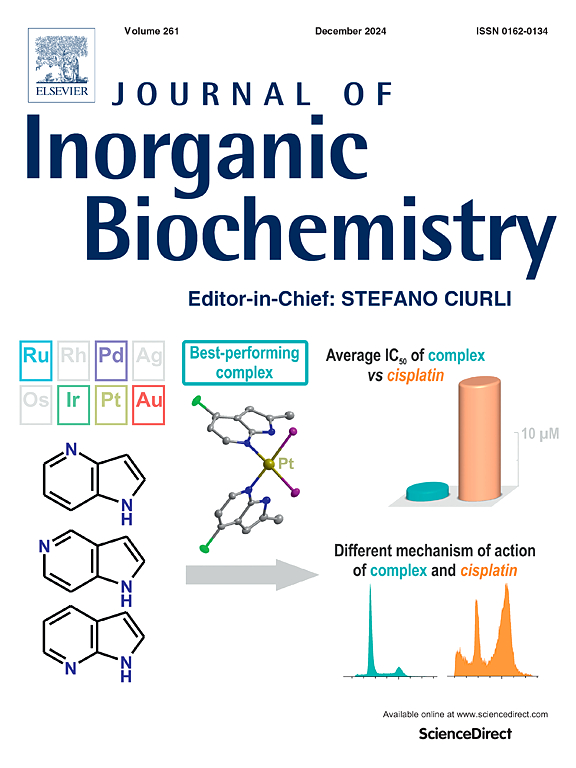Copper complexes induce haem oxygenase-1 (HMOX1) and cause apoptotic cell death in pancreatic cancer cells
IF 3.8
2区 化学
Q2 BIOCHEMISTRY & MOLECULAR BIOLOGY
引用次数: 0
Abstract
Pancreatic ductal adenocarcinoma (PDAC), the most common pancreatic malignancy, has a dismal 5-year survival rate, making palliative chemotherapy the only treatment option. Targeted therapy has limited efficacy in PDAC, underscoring the need for novel therapeutic approaches. The inducible stress-response protein, haem oxygenase-1 (HMOX1), has been implicated in treatment failure in PDAC.
Copper coordination complexes have shown promise as anticancer agents against various cancers, and are associated with apoptotic cell death. The different ligands to which copper is complexed, determine the specificity and efficacy of each complex.
Three different classes of copper complexes were evaluated for anti-cancer activity against AsPC-1 and MIA PaCa-2 pancreatic cancer cell lines. A copper-phenanthroline-theophylline complex (CuPhTh2), a copper-8-aminoquinoline-naphthyl complex (Cu8AqN), and two copper-aromatic-isoindoline complexes (CuAIsI) were effective inhibitors of cell proliferation with clinically relevant IC50 values below 5 μM. The copper complexes caused reactive oxygen species (ROS) formation, promoted annexin-V binding, disrupted the mitochondrial membrane potential (MMP) and activated caspase-9 and caspase-3/7, confirming apoptotic cell death.
Expression of nuclear HMOX1 was increased in both cell lines, with the CuPhTh2 complex being the most active. Inhibition of HMOX1 activity significantly decreased the IC50 values of these copper complexes suggesting that HMOX1 inhibition may alter treatment outcomes in PDAC.

铜配合物诱导血红素加氧酶-1 (HMOX1)并引起胰腺癌细胞凋亡。
胰腺导管腺癌(PDAC)是最常见的胰腺恶性肿瘤,其5年生存率很低,姑息性化疗是唯一的治疗选择。靶向治疗在PDAC中的疗效有限,强调需要新的治疗方法。诱导应激反应蛋白血红素加氧酶-1 (HMOX1)与PDAC治疗失败有关。铜配位配合物已显示出抗癌药物的前景,并与凋亡细胞死亡有关。铜与不同的配体络合,决定了每种络合物的特异性和有效性。研究了三种不同类型的铜配合物对胰腺癌细胞系AsPC-1和MIA PaCa-2的抗癌活性。一个铜-菲罗啉-茶碱配合物(CuPhTh2)、一个铜-8-氨基喹啉-萘配合物(Cu8AqN)和两个铜-芳香-异吲哚啉配合物(CuAIsI)是有效的细胞增殖抑制剂,其临床相关IC50值低于5 μM。铜配合物引起活性氧(ROS)的形成,促进膜联蛋白v的结合,破坏线粒体膜电位(MMP),激活caspase-9和caspase-3/7,证实凋亡细胞死亡。细胞核HMOX1在两种细胞系中的表达均有所增加,其中CuPhTh2复合物的表达最为活跃。抑制HMOX1活性可显著降低这些铜复合物的IC50值,表明抑制HMOX1可能会改变PDAC的治疗结果。
本文章由计算机程序翻译,如有差异,请以英文原文为准。
求助全文
约1分钟内获得全文
求助全文
来源期刊

Journal of Inorganic Biochemistry
生物-生化与分子生物学
CiteScore
7.00
自引率
10.30%
发文量
336
审稿时长
41 days
期刊介绍:
The Journal of Inorganic Biochemistry is an established international forum for research in all aspects of Biological Inorganic Chemistry. Original papers of a high scientific level are published in the form of Articles (full length papers), Short Communications, Focused Reviews and Bioinorganic Methods. Topics include: the chemistry, structure and function of metalloenzymes; the interaction of inorganic ions and molecules with proteins and nucleic acids; the synthesis and properties of coordination complexes of biological interest including both structural and functional model systems; the function of metal- containing systems in the regulation of gene expression; the role of metals in medicine; the application of spectroscopic methods to determine the structure of metallobiomolecules; the preparation and characterization of metal-based biomaterials; and related systems. The emphasis of the Journal is on the structure and mechanism of action of metallobiomolecules.
 求助内容:
求助内容: 应助结果提醒方式:
应助结果提醒方式:


